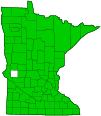smooth Solomon’s seal
(Polygonatum biflorum var. commutatum)
Conservation • Wetland • Description • Habitat • Ecology • Use • Distribution • Taxonomy
Description |
||
Smooth Solomon’s seal is a 12″ to 48″ tall, erect, perennial forb that rises on a single stem from a knotty rhizome. The rhizome has conspicuous, large scars that mark the position of the stems of previous years. The stems are erect, arching, unbranched, leafy, and hairless. They are not jointed at the leaf axils. The leaves are alternate, stalkless, often clasping, narrowly lance-shaped to broadly elliptic, 3½″ to 8″ long, and 1⅛″ to 3½″ wide. They have 7 to 19 conspicuous, parallel veins. The upper surface is green and hairless with recessed veins. The lower surface is paler green, hairless, somewhat covered with a whitish, waxy coating (glaucous), with prominent (raised) veins. The inflorescence is a small cluster of 2 to 15, though usually 10 or fewer, flowers hanging downward from most leaf axils. The cluster stalk (peduncle) is green, flattened, and arched like a bow, but not strongly bent backward. It is ½″ to 1½″ long when in flower, elongating to 2½″ to 3½″ when in fruit. The individual flower stalks are shorter than the peduncle. The flowers are ½″ to ⅔″ long. There are 3 greenish-white or yellowish-green petals and 3 similar sepals (6 tepals) united at the base into a cylinder-shaped tube ending in 6 short, erect, flared, or spreading lobes. There are 6 stamens and 1 style that do not protrude from the tube. The fruit is a globular berry, 5 ⁄16″ to ½″ long, with several seeds. It is initially green, becoming dark blue-violet when it ripens. |
||
Height |
||
12″ to 48″ |
||
Flower Color |
||
Greenish-white or yellowish-green |
||
Similar Species |
||
Common false Solomon’s seal (Maianthemum racemosum var. racemosum) is a shorter plant, reaching no more than 30″ at maturity. The stem sometimes zigzags. The leaves usually have only 3, sometimes 4 or 5, parallel veins. The inflorescence is plume-like, with white star-shaped flowers on a branched panicle at the end of the main stem. The fruits are green with reddish-purple spots when young and pink to red when mature. Hairy Solomon’s seal (Polygonatum pubescens) is a shorter plant, reaching no more than 36″ at maturity. The leaves are on short stalks and have minute hairs growing along the veins on the underside of the leaves and on the edges of the leaves. These hairs can be very hard to see. They have 3 to 9 parallel veins. Large-flowered bellwort (Uvularia grandifloria) is a much shorter plant, reaching no more than 20″ at maturity. The leaves are perfoliate and have 3 to 5 prominent veins. The flowers are bell-shaped, 1″ to 2″ long, and bright yellow. The fruit is a 3-celled, greenish to yellowish-brown capsule. Rose twisted-stalk (Streptopus lanceolatus var. longipes) is a shorter plant, reaching no more than 36″ at maturity. The stems are hairy, branching, and jointed at the leaf axils giving them a zigzag appearance. The leaves do not clasp the stem. The flowers are dark rose-purple to pink and bell-shaped. The petal-like tepals are not united at the base and turn backward at the tip. They hang singly on stems up to 2″ long that are twisted or have an abrupt bend in the middle. The fruit is bright red. Starry false Solomon’s seal (Maianthemum stellatum) is a much shorter plant, reaching no more than 24″ at maturity. The stem is more erect, reclining only slightly. The leaves are lily-like, narrow, and lance-shaped. The upper leaves are usually stiff and erect or spreading. The inflorescence is spike-like, with white star-shaped flowers in an unbranched cluster at the end of the stem. The fruits are yellowish-green when young with 3 to 6 red to purple stripes, and dark blue to reddish black when mature. |
||
Habitat |
||
Dry to moderate moisture. Woods, prairies, thickets, roadsides. Full to partial sun. |
||
Ecology |
||
Flowering |
||
May to July |
||
Pests and Diseases |
||
|
||
Use |
||
|
||
Distribution |
||||
|
Sources |
|||
| 4/30/2023 | ||||
Nativity |
||||
Native |
||||
Occurrence |
||||
|
||||
Taxonomy |
|||
| Kingdom | Plantae (Plants) | ||
| Division | Tracheophyta (Vascular Plants) | ||
| Subdivision | Spermatophytina (Seed Plants) | ||
| Class | Liliopsida (Monocots) | ||
Order |
Asparagales (Agaves, Orchids, Irises, and Allies) | ||
Family |
Asparagaceae (agave and allies) | ||
| Subfamily | Nolinoideae (dragon tree) | ||
| Tribe | Polygonateae (true and false Solomon’s seals) | ||
Genus |
Polygonatum (Solomon’s seals) | ||
| Section | Polygonatum (alternate-leaved Solomon’s seals) | ||
| Species | Polygonatum biflorum (smooth Solomon’s seal) | ||
Up to five subspecies of smooth Solomon’s seal have been described. The most common by far, and the only variety found in Minnesota, is var. commutatum. It is usually larger, has more flowers per peduncle, and has more veins per leaf than the nominate variety, var. biflorum. While the varieties can be separated locally, it has not been possible to separate them geographically. For this reason, some authoritative sources, including ITIS, GRIN, Plants of the World Online, and World Flora Online, do not recognize any varieties. |
|||
Synonyms |
|||
Convallaria biflora Polygonatum canaliculatum Polygonatum biflorum var. melleum Polygonatum cobrense Polygonatum commutatum Polygonatum giganteum Polygonatum melleum |
|||
Common Names |
|||
American Solomon’s seal drop berry giant Solomon’s seal great Solomon’s-seal King Solomon’s seal King Solomon’s-seal sealwort small Solomon’s seal smooth Solomon’s seal Solomon’s seal Solomon’s-seal |
|||
Glossary
Axil
The upper angle where the leaf stalk meets the stem.
Clasping
Describing a leaf that wholly or partly surrounds the stem but does not fuse at the base.
Glaucous
Pale green or bluish gray due to a whitish, powdery or waxy film, as on a plum or a grape.
Peduncle
The stalk of a single flower or flower cluster.
Perfoliate
A leaf having margins that entirely surround the stem, giving the appearance that the stem is growing through the leaf.
Rhizome
A horizontal, usually underground stem. It serves as a reproductive structure, producing roots below and shoots above at the nodes.
Sepal
An outer floral leaf, usually green but sometimes colored, at the base of a flower.
Tepal
Refers to both the petals and the sepals of a flower when they are similar in appearance and difficult to tell apart. Tepals are common in lilies and tulips.
Visitor Photos |
|||||
Share your photo of this plant. |
|||||
| This button not working for you? Simply email us at info@MinnesotaSeasons.com. Attach one or more photos and, if you like, a caption. |
|||||
|
|||||
MinnesotaSeasons.com Photos |
|||||
Habitat |
|||||
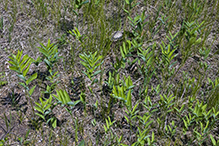 |
|||||
Plant |
|||||
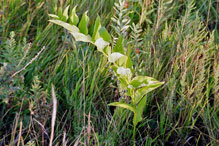 |
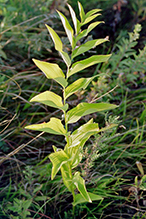 |
||||
Infructescence |
|||||
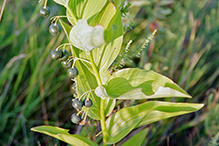 |
|||||

Slideshows |
||

Visitor Videos |
|||
Share your video of this plant. |
|||
| This button not working for you? Simply email us at info@MinnesotaSeasons.com. Attach a video, a YouTube link, or a cloud storage link. |
|||
Other Videos |
|||
| Polygonatum biflorum (without class bit).mp4 newenglandwild's channel |
|||
About
Uploaded on Jul 26, 2011 Dan Jaffe continues his series of native plant videos with Polygonatum biflorum, common name: King Solomon's-seal. |
|||
| 08 Polygonatum biflorum Séquence 10-Vivaces printanières 1.m4v Jean Désorcy |
|||
About
Uploaded on Jan 9, 2010 Le Sceau de Salomon verticillé du printemps à l'automne. Salomon's seal from spring to fall. Polygonatum biflorum de la primavera hasta el otoño. |
|||
| Edible & Medicinal Solomon's Seal ( Polygonatum biflorum ) Prepare2Survive |
|||
About
Published on May 7, 2012 MORE INFO - http://www.pfaf.org/user/Plant.aspx?LatinName=Polygonatum+biflorum Edible, Medicinal, Solomon's Seal, Polygonatum, biflorum, commutatum, wild, plant, ethnobotany, bushcraft, survival, |
|||
| Plant Comparison: True And False Solomon's Seal MiWilderness |
|||
About
Published on May 10, 2012 More Solomon's Seal showing flowers: http://youtu.be/yF2t2YUWIgw Polyonatum biflorum. Music: http://incompetech.com/ These two plants are entirely unrelated belonging to completely different genera. But, they look quite similar until close inspection reveals the vast differences. Both true and False Solomon's Seal are reported to have medicinal and edible qualities. Solomon's Seal is quite rare locally, but False Solomon's Seal is fairly abundant. Native Americans reportedly used these two plants for both food and medicine. Modern herbalists still recommend Solomon's Seal, properly prepared, as an excellent relief for pain associated with joint, tendon, cartilage and back injuries. Tags: Plant comparison Solomon's seal false solomon's seal identification "edible and medicinal plants" eastern woodlands michigan polygonatum biflorum smilax ethical harvest protected species pickers flowers "edible roots" rhizome berry midwest "primitive skills and technology" survival bushcraft prepping morel ash woodsman forager neolithic native american ethnobotany herbal remedy medicine history health joint pain lubricating strains sprains tendonitis wrist elbow knee "natural back pain relief" |
|||
| Bumblebees on Smooth Solomon's Seal Wildflower Farm |
|||
About
Published on Jun 5, 2014 A compilation of bumblebees as they visit Smooth Solomon's Seal at Wildflower Farm. They use buzz pollination to shake out pollen from the deep flower tubes. |
|||

Visitor Sightings |
|||||
Report a sighting of this plant. |
|||||
| This button not working for you? Simply email us at info@MinnesotaSeasons.com. Be sure to include a location. |
|||||
|
|||||
MinnesotaSeasons.com Sightings |
|||||
Avon Hills Forest SNA, North Unit Bertram Chain of Lakes Regional Park Carpenter St. Croix Valley Nature Center Charles A. Lindbergh State Park Clifton E. French Regional Park Kellogg Weaver Dunes SNA, Kellogg Weaver Unit Minnesota Valley NWR, Louisville Swamp Unit Nerstrand Big Woods State Park P.N. and G.M. Nelson Wildlife Sanctuary |
|||||

|
Created: Last Updated: © MinnesotaSeasons.com. All rights reserved. |
